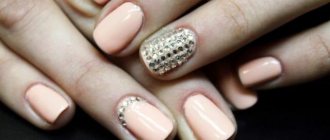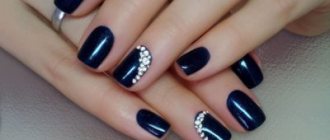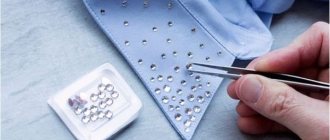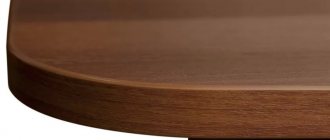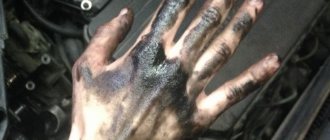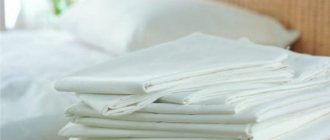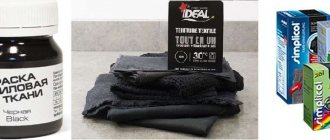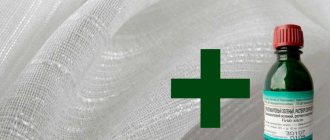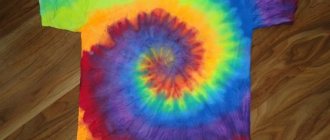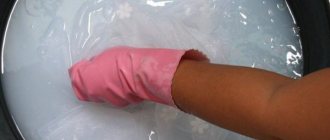Rhinestones have long gained popularity among girls as decorative elements on various items of clothing and accessories. However, decoration with rhinestones can not only be factory-made; you can independently diversify, refresh or emphasize the beauty of your clothes with purchased rhinestones. In this case, it is important to carefully and accurately attach the rhinestones to the surface.
In this article we will learn how to glue jewelry to fabric and select the appropriate glue.
Glue for rhinestones
The easiest way to glue rhinestones is with special glue. A correctly selected composition will ensure not only reliable fastening of the rhinestone, but also a beautiful appearance of the product.
- Epoxy resin is a universal adhesive for all types of surfaces except glass. When using this type of fabric glue, it must be remembered that the resin can leave noticeable marks and its final fixation occurs after many hours.
- Special fabric adhesive comes in airtight containers that have a pointed top. This allows you to carefully place the required amount of adhesive at the fastening site. After drying and hardening, the mass becomes transparent and invisible.
What glue should I use to glue the rhinestones?
To achieve an ideal result, it is better to use special types of glue. Often the initial color of the glue is matte and white, this is necessary for ease of dosing.
It is not recommended to use adhesives containing acetone or acetic acid, as these substances can worsen the appearance of the products. Below are the common types of glue and their features.
Glue "Moment-Crystal"
It has an odor, which can negatively affect your well-being if you work with it for a long time. It has a transparent texture and is quite easy to apply. It stretches a little, but dries quickly on the surface to form a film. When applying decoration, a drop of glue may rupture and some of the liquid contents will fall onto adjacent areas of the material. The setting of the rhinestone occurs quickly and it is not possible to adjust its position.
Fevicryl Fabric Glue (India)
The bottle has a convenient applicator spout. The composition is based on epoxy paste (odorless, easy to apply, non-stretchy). The texture of the adhesive is initially white, which after drying becomes completely transparent.
After applying the rhinestone to the dried drops of glue, you can adjust its position within a few seconds. The adhesive sets quickly, does not lose its plasticity and does not deform the product. It is also convenient to work with on vertical surfaces.
Complete drying occurs within 24 hours. Using a household hairdryer will reduce waiting time.
A product with glued rhinestones can be washed in cold water after a week.
Textile adhesive E6000 CRAFT (USA)
Odorless, viscous, prone to the formation of threads between drops. Excess glue is easily and completely removed from the surface. The composition has high adhesion and forms a strong and elastic connection. This type of glue is especially often used for Swarovski rhinestones, since its composition is neutral to their foil surface. Also, its waterproof formula allows the product to be used in fresh water, sea water and machine washable.
Glue for rhinestones Danscouture (USA)
The emulsion is water-based and non-toxic. After drying, the glue becomes transparent and does not cause deformation of the surface of the fabric. Ideal for all textile fabrics, but not used for leather products.
Intended for gluing rhinestones with a flat bottom, popular in use for decorating the costumes of figure skaters, gymnasts and dancers.
Epoxy adhesive for Swarovski rhinestones CG 500-35 (USA)
This type of glue is widely used in the jewelry industry. At home, you can use it to independently decorate electronics cases with rhinestones, decorate various accessories, interior items, etc.
The adhesive composition demonstrates the highest adhesive qualities when working with various metal surfaces, synthetic materials, rubber, glass, porcelain or wood. This type of glue is not used for fabric; stains will remain.
Method one - glue
The glue for fixing rhinestones must be specialized. This will ensure that the crystals are securely attached.
We recommend:
- E6000 adhesive from Eclectic Products.
Ideal for gluing rhinestones to any fabric. Does not destroy the back foil surface of the rhinestones. The fabric retains its elasticity after use. Does not leave marks, does not crumble in the cold. Waterproof – can be used in fresh and salt water once fully cured; Machine washable. The glue dries in 3-4 hours; it is recommended to use the product no earlier than after 24 hours. After gluing, excess glue around the rhinestones can be easily removed. Does not contain ethyl alcohol!
- Crystal Hobby Glue.
White glue, alcohol based. After drying, it becomes transparent, the crystals are firmly fixed to the fabric. Products with this type of glue must not be soaked. Wash at 30C. The tube is equipped with a convenient spout.
To use special glue, craftsmen have different technologies.
1. Glue on the crystal.
It is enough to drop a small amount of glue onto the stone and quickly attach the crystal to the desired place. To set, hold it a little, pressing lightly on it.
2. Glue on the fabric.
Squeeze glue along the design lines. Then, using tweezers or an applicator, place the rhinestones onto the glue and press lightly. The glue dries slowly, so you have time to complete all the work.
When attaching large stones, do not forget to apply glue along their edges. The larger and heavier the stone, the better its edges must be processed.
Types of rhinestones
Depending on the material from which they are made, there are:
- Metal.
- Glass.
- Acrylic rhinestones.
Glass rhinestones or crystals are available with different lead or zinc contents, providing a different play of light. Acrylic rhinestones are made of plastic. Of course, cheaper and lighter than glass or crystal. Over time, they may become cloudy and lose their presentation during wear and washing.
How to glue rhinestones onto fabric?
The general rule for gluing rhinestones to fabric is as follows:
- The required amount of glue is applied to the material. A drop of adhesive should spread and penetrate the surface of the fabric. To do this you need to wait a few seconds. Please note that thick fabrics will require more glue than thin ones. The volume of the drop should be such that a small amount of glue extends beyond the decoration, securely “enveloping” it around the perimeter.
- If you are working with elastic materials such as lycra , jersey or nylon , then the material must be stretched before gluing. When working with a finished product, it is recommended to place a thick sheet of cardboard between layers of material. This will prevent glue from getting onto the lower layers of the material.
- The stone should be picked up with tweezers, miniature forceps, a wax stick or a plastic stick with a drop of wax on the end, but not with your fingers. You can also pry off the rhinestones with a toothpick. The crystal is placed in the center of the drop, after which it should be pressed lightly.
You can apply glue directly to the rhinestone, but this requires skill and experience. Peeling the stone from the fabric if it is not placed correctly will leave marks and will look sloppy. Before working with a finished product, it can be useful to practice on a small area of unnecessary fabric.
Important! It should be remembered that thin fabrics such as organza do not hold rhinestones well. You should also not glue stones to any type of leather, including artificial leather.
Tips for a needlewoman
In the old days they told me to learn to embroider on matting, and then on scoured cloth. A similar recommendation is addressed to novice decorators with rhinestones: by practicing on not the best items in your wardrobe, you can understand the principle of working with decoration and find out which company supplies the best material.
Be sure to take into account the presence of other accessories on clothing : zippers and buttons may interfere with the uniform treatment of the surface with rhinestones by the iron.
Advice! Places with small surfaces that are difficult to reach with an iron can be decorated with a soldering iron, gluing each part separately. Don't know how or are afraid to work with a soldering iron? You can use a candle and tweezers: after heating each rhinestone on the fire, quickly and carefully glue it. The method is also good for fabrics that do not like high temperatures.
Having mastered pasting clothes with thermal rhinestones, you can try decorating shoes - for example, masking scuff marks on your favorite but slightly worn boots. For this:
- A drawing is applied with a gel pen;
- Before gluing the decor, the trace of the handle is carefully wiped off with a cotton swab and alcohol or acetone. Acetone spread over the surface of the skin is fraught with indelible stains !
- Using a soldering iron or a candle, each element of the pattern is glued.
Will the skin suffer from such manipulations? No - a fairly coarse material can survive heating of about 180 degrees. Only the varnished surface raises doubts.
Rhinestones are a means for decorating clothing, interior items, canvas, plastic and other surfaces. In order to make decorative trim with rhinestones, you don’t need any special skills, just take an iron and put in a little effort.
How to glue rhinestones with an iron?
This method is used for self-adhesive or hot-melt rhinestones (HotFix), when an adhesive composition has already been applied to the back surface of the stone.
First way
The task does not look difficult when the stones are the same size and are arranged closely on the product. They just need to be placed correctly, covered with gauze and gently ironed.
The iron temperature depends on the type of fabric. Excessive heating of the glass should be avoided so as not to cause deformation of the fabric. But at the same time, the heating must be sufficient, otherwise the crystals will not stick. Under the influence of heat, the adhesive penetrates into the fabric, providing a reliable connection.
Second way
It is necessary to place the iron with the sole up (for example, putting it on a stand for ironing sleeves). Place the rhinestones on the cold surface of the iron with the adhesive side up. Apply the desired pattern on paper. Place the sheer fabric over the design.
Heat the iron to medium temperature and wait for the glue to boil. Pry the needle and quickly transfer the stones to the fabric, turning them over. Use the free finger of the other hand to press to ensure tight contact of the hot decoration with the material.
For safety reasons, it is recommended to wrap your finger in cloth.
Working with an iron, soldering iron, gun with silicone rods
Correctly performed manipulation can guarantee reliable fixation, and this is perhaps the most important thing, because fallen rhinestones spoil clothes and leave behind traces of glue. To make everything beautiful and neat, the easiest way is to buy a ready-made application. It is placed in the place where you want to get a pattern of stones, covered with gauze and rubbed several times with a well-heated iron. The glue melts, penetrates deep into the fibers and securely fixes the rhinestones.
A soldering iron is convenient because it allows you to attach decor to the product without any problems. The device is heated to the desired temperature, the nozzle is aimed at the crystal, the adhesive applied to the base becomes soft and fixes the decorative element on the surface of the fabric.
The hot glue gun requires careful handling. After heating, silicone can get on your fingers and leave a burn. You need to glue each rhinestone separately, applying a little adhesive to the base of the rhinestone. It is then placed in place and pressed firmly. For this manipulation you will need tweezers to grab small decorative elements.
Using the applicator
There are fabrics that cannot stand the touch of an iron. For example, velvet. This is where a convenient soldering iron applicator with various attachments will come to the rescue. The attachments vary depending on the size of the rhinestone and allow you to heat the jewelry precisely and evenly.
The device itself is small and easy to use. The applicator will be indispensable for gluing individual hot-melt adhesive rhinestones. The device must be held still to accurately place the crystal on the fabric and ensure excellent results.
There are vacuum models of applicators that are equipped with a special pump; it draws in and holds the rhinestones.
How to lay out rhinestones?
Before you begin the gluing process, you should lay out the desired design on paper or transparent tracing paper.
To transfer a design to fabric, you can use special crayons or pencils, traces of which can be easily removed from the surface of the material. It is recommended to wash the fabric itself or degrease it with alcohol before applying the adhesive. It is often convenient to fix the desired area in a hoop.
How to glue rhinestones to a swimsuit?
Gymnastics leotards are often decorated with rhinestones. Preference, as a rule, is given to large specimens so that they are noticeable from afar. Crystals are often laid out in the form of an original design.
Before gluing the decorations, the swimsuit should be stretched. You should start working from the periphery - sleeves, skirts and then move to the center of the product. Using a dispenser, apply the required amount of special glue (for example, Danscouture) directly to the swimsuit. The rhinestones need to dry within 24 hours.
conclusions
Rhinestones are used to decorate clothes, interior items, dishes, and lay out paintings. The method of attaching crystals to decorate the surface must be selected taking into account the material (plastic, ceramics, type of fabric), the area of the surface to be processed, technical capabilities, and the skill of the needlewoman.
For processing clothes, it is recommended to choose a hot-melt adhesive or an adhesive base decoration method. To process more complex surfaces, such as ceramics, solution-mounted crystals can be used. And crystals in baskets are perfect for making beautiful ribbons, chains, necklaces or bracelets.
Rhinestones are one of the most popular types of decor for women's clothing and accessories. They are used by both famous designers and craftswomen who create unique textile products and home decor items with their own hands. You can decorate even the most inconspicuous thing with rhinestones and sequins, and it will find a new life.
These decorative elements are attached to the material in different ways. How to glue crystals to a dress so that they stick well? What glue is suitable for working with fabric? How to care for clothes with rhinestones and sequins?
Decoration with Swarovski crystals
Popular around the world, Swarovski crystals are a symbol of quality, impeccable style and cutting-edge design. Rhinestones are often used to decorate interior items, items of clothing or shoes, mobile phone cases, and various other accessories. For working on hard surfaces, it is better to use stones with a flat bottom.
Before decorating, it is necessary to thoroughly degrease the surface on which the crystals will be applied. They will be securely secured with a two-component epoxy adhesive, for example, CG-50-35. After applying the mixture to a grease-free, dry surface, quickly place and fix the crystals by lightly pressing on them.
When using Swarovski crystals with a hot-melt adhesive base, they should be placed on the material and ironed from the back.
Method two - hot melt
Thermal rhinestones attach best to medium-weight fabrics - cotton, linen, wool. The glue easily penetrates the fibers and binds them to the back of the jewelry.
To fix thermal rhinestones you will need the following tools:
- Soldering iron or hot-melt applicator
It is convenient due to its compactness: you can simply hold the product in your hands during operation. It has a set of attachments that allows you to work with rhinestones of different sizes. Thanks to them, the soldering iron glues the crystal locally, exclusively at the point of contact of the fabric with the stone. Therefore, it is ideal for working in hard-to-reach areas of clothing or shoes.
- Iron. An ordinary household appliance or a small iron for needlework.
There are also several gluing technologies:
1. The stone is placed on the fabric with the thermal base down and the soldering iron is pressed against it. This option is convenient when you decide to first lay out the design with pebbles, and then attach them with a thermal applicator.
2. The rhinestones are laid out with the backing up on the table, heated with a soldering iron and the rhinestone is transferred to the product. It is important to experimentally select the time for gluing. You should start with 4-7 seconds.
3.To glue rhinestones onto fabric with an iron, cover the pattern with a sheet of paper, select the “cotton” temperature setting (160 – 180C) and slowly iron for 20-30 seconds. You need to apply a little pressure on the iron to increase the adhesion of the pattern to the surface of the clothing.
Using any technique or method, allow the glue to dry for 24 hours without moving the item from the surface on which you glued the crystals.
Caring for products with rhinestones and crystals
Products with rhinestones certainly require careful care and delicate handling during washing and ironing:
- you should not soak such things;
- Hand washing at low temperatures is recommended;
- It is better to use liquid detergents for delicate fabrics;
- the use of conditioner is unacceptable, since the substances included in its composition significantly reduce the adhesion of the adhesive;
- during ironing, direct contact of the hot surface of the iron with decorated areas should be avoided;
- should be ironed through gauze or any other material.
We use thermal rhinestones
This type of decor is best suited if you really don’t want to think about how to glue rhinestones onto clothes. Their lower surface is covered with a special compound, which, when heated, tightly connects the shiny pebbles to the fabric.
- Rhinestones are placed on things in the required sequence.
- Then the product is covered with gauze or other fabric that can withstand heat well.
- On top of it, carefully, trying not to move the rhinestones, apply an iron heated at a suitable temperature.
The connection is quite strong; the glitter can only be torn off with physical force. For this reason, decorated items should not be washed in a machine - there is a high chance of ruining the decor itself and damaging the parts of the washing machine with small elements. Rhinestones on clothes usually survive careful hand washing without any consequences.
